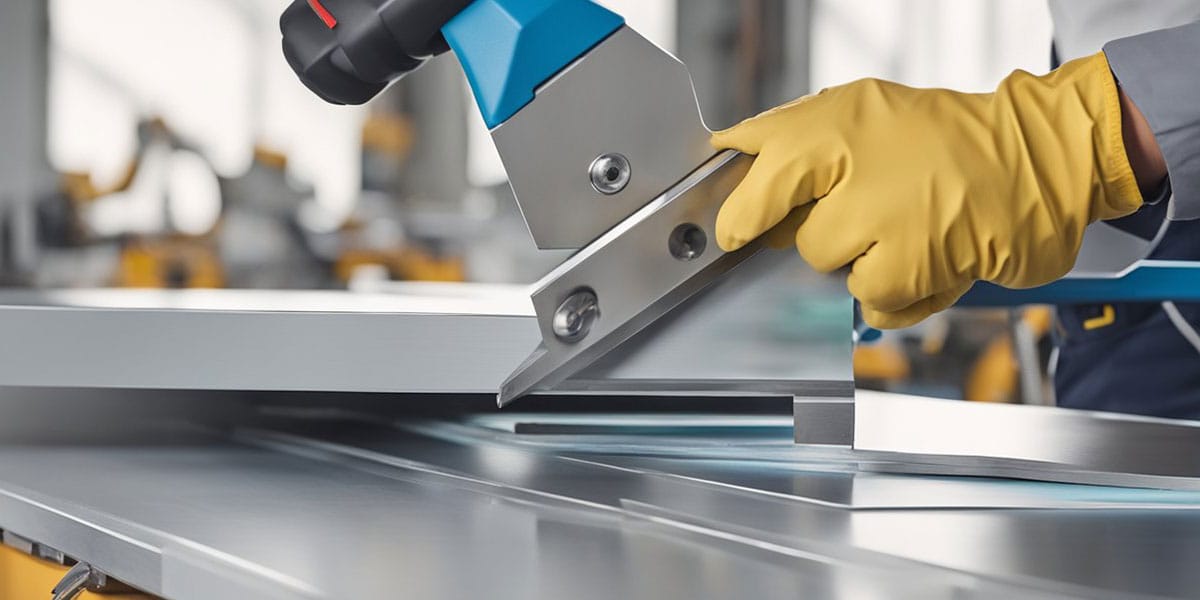
06 Jul Step-by-Step Guide to Installing Aluminum Wall Panels in 2025
Table of Contents
You might wonder, “How do I install aluminum wall panels?” Good news—these modern metal wall panels are easy to install, even if you have never tackled a simple diy project before. You just need the right tools and a bit of patience. Whether you want to upgrade a home wall or a business space, you can handle the installation yourself. Many people choose aluminum wall panels because they look great and work well for diy projects. Stay safe, measure carefully, and watch your wall transform!
Key Takeaways
- Prepare your wall by cleaning, inspecting, and adding a vapor barrier to protect against moisture.
- Gather all necessary tools and safety gear before starting to make installation easier and safer.
- Measure carefully and cut panels precisely, handling them gently to avoid damage.
- Use the right fasteners or clip systems and check panel alignment often for a strong, professional finish.
- Seal edges and trims well, and clean and inspect your panels yearly to keep them looking great and lasting long.
Tools & Materials
Tools Checklist
You want to start with the right tools. Having everything ready makes the job smoother and faster. Here’s a handy checklist to help you get started:
- Tape measure (for measuring your wall)
- Level (to keep panels straight)
- Chalk line (for marking lines)
- Power drill and bits
- Metal snips or a circular saw with a metal blade
- Screwdriver
- Rubber mallet
- Caulking gun
Tip: Double-check your tool kit before you begin. Missing tools can slow you down!
Materials for Aluminum Wall Panels
You need the right materials for a strong and good-looking finish. Aluminum wall panels come in many styles. Some people like the look of aluminum siding, while others prefer standing seam siding or even metal shingle cladding. Each style gives your wall a unique look.
Here’s a table to help you organize your materials:
Material | Purpose |
|---|---|
Main surface covering | |
Starter strips | Base support for first panel |
Fasteners (screws, clips) | Attach panels to the wall |
Trim pieces | Finish edges and corners |
Vapor barrier | Protects wall from moisture |
Sealant | Seals gaps and joints |
You might also need extra panels if you plan to cover a large wall or if you want to practice cutting.
Safety Gear
Safety comes first. You want to protect yourself while working with metal panels. Here’s what you should wear:
- Safety glasses 👓
- Work gloves 🧤
- Ear protection
- Dust mask
Note: Always wear gloves when handling aluminum panels. The edges can be sharp!
With these tools, materials, and safety gear, you’re ready to start your aluminum wall panel project. You’ll find that careful preparation makes the rest of the installation much easier.
Wall Preparation
Clean & Inspect Wall
Before you install any aluminum panels or diamond plate sheets on a wall, you need to make sure your wall is ready. Start by removing dust, dirt, or old paint. Use a broom or vacuum to get rid of loose debris. If you see any stains or sticky spots, wash them with water and a mild detergent. Always begin cleaning at the top of the wall and work your way down. For tough spots, try a soft brush or sponge. If you find oil or wax, use a safe solvent, but be careful not to damage the surface. After cleaning, check every seam and corner. Make sure everything is dry and there are no stains left behind. Look for cracks, holes, or rough patches. Fill small holes and sand them smooth. If you see rust or old paint, remove it with a scraper or sandpaper.
Tip: Always protect nearby surfaces from cleaning run-off and avoid harsh chemicals that could harm your wall or your health.
Waterproofing & Vapor Barriers
Now that your wall is clean, you need to keep moisture out. Install a vapor barrier to stop water from getting behind your aluminum panels. Roll out the barrier from the base of the wall and work your way up. Overlap the sheets by a few inches to make sure there are no gaps. Press the barrier flat against the wall and seal the edges with tape or caulk. This step helps prevent mold and keeps your wall strong for years.
Marking & Alignment
Getting your panels straight starts with good markings. Use a level and a chalk line to draw a straight reference line at the base of the wall. This line will guide your first row of panels or sheets. Always start at the bottom and work up. Double-check your lines before you install anything. If your wall is long, measure and mark every few feet to keep everything square. Good alignment makes your finished wall look professional and helps the panels fit tightly together.
Cutting & Handling Panels
 Cutting Aluminum Wall Panels
Cutting Aluminum Wall Panels
You want your aluminum wall panels and sheets to fit perfectly. Start by measuring each piece before you cut. Use a tape measure and mark your lines with a pencil or chalk. For most projects, saw cutting works well. It lets you cut several sheets at once, but you might need to smooth out rough edges with a file. If you need very precise cuts, try laser or waterjet cutting. Laser cutting gives you smooth, accurate edges, which is great for detailed work or tight spaces. Waterjet cutting keeps the metal cool and avoids heat marks. Both methods help you get a clean finish when you install the diamond plate sheets on a wall.
Tip: Always choose your cutting method based on the thickness of your panels and the look you want for your wall.
Handling & Protection
Aluminum panels and sheets can get scratched or bent if you do not handle them carefully. Always carry panels on their side to keep them rigid. If you have long sheets, ask a friend to help so you do not drop or bend them. Store your panels upright on pallets, not directly on the ground. Keep them dry and covered, but make sure air can flow around them. When you install diamond plate sheets, remove any protective film just before you put them on the wall. This keeps the finish looking new. Never stack panels with the painted sides facing out, as this can cause scratches.
- Move only one or two sheets at a time.
- Make sure coated sides face each other during storage.
- Keep storage areas cool and dry.
Safety Tips
Cutting and handling aluminum wall panels and sheets can be risky if you do not use the right safety gear. Always wear cut-resistant gloves to protect your hands from sharp edges. Safety glasses keep your eyes safe from flying bits of metal. Use a dust mask if you are cutting many sheets, especially indoors. Never use a torch to cut aluminum panels, as this can damage the finish and make the sheets unsafe to install. When you install the diamond plate, check for burrs or sharp spots and smooth them out before you finish the wall.
Note: Take your time and double-check every step. Careful cutting and handling help you install diamond plate sheets on a wall that looks sharp and lasts for years.
Install Aluminum Wall Panels
Fasteners & Clip Systems
You want your aluminum wall panels to stay secure for years. Start by choosing the right fasteners and clip systems. Most people use screws, rivets, or special clips to attach panels to the wall. Mechanical fasteners work well for both home and commercial projects. They hold the sheets tight and help the panels resist wind and weather.
Clip systems make the job easier. You fasten clips to the wall first, then snap the panels into place. This method lets the panels move a little as temperatures change. It also helps prevent warping or buckling. The Longboat Key project used a 1.5” mechanical standing seam system with aluminum panels. This system handled tough coastal weather and curved surfaces. The clips applied steady pressure, keeping the panels in place even in salty air.
You can pick between single lock and double lock seams. Single lock seams fold once and work well for mild climates. Double lock seams fold twice and give you extra protection against water and wind. These systems have passed tests for wind, water, and impact. They also qualify for commercial warranties. Engineers have tested seam-clip connections using advanced models and real-world experiments. These tests show that clip-fastened aluminum wall panels perform well, even in harsh conditions.
Tip: Always follow the manufacturer’s instructions for fastener type and spacing. This step keeps your installation strong and safe.
Click-Channel & Snap-On Rails
Some aluminum wall panels use click-channel or snap-on rail systems. These systems make installation faster and cleaner. You attach the rails or channels to the wall first. Then you click or snap the panels onto the rails. This method hides the fasteners and gives your wall a smooth, modern look.
Click-channel systems work well for both vertical and horizontal panels. Snap-on rails help you line up each sheet perfectly. You do not need to drill through the face of the panel, so the finish stays flawless. Many people like this system for installing metal siding or standing seam siding on homes and offices.
- Click-channel systems reduce installation time.
- Snap-on rails keep panels straight and tight.
- Both systems allow for easy panel removal if you need repairs.
Note: Always check that each panel locks fully into the channel or rail before moving to the next one.
Panel Alignment & Spacing
Getting your panels straight is key to a professional finish. Start at the base of the wall. Use your chalk line and level to mark a reference line. Place your starter strip along this line. This step helps you install metal wall panels in a straight row.
Space your fasteners or clips evenly. Most manufacturers recommend spacing them every 12 to 24 inches. This spacing keeps the sheets flat and secure. If you use click-channel or snap-on rails, follow the spacing guidelines for those systems.
Check the alignment of each panel as you go. Use a level to make sure the panels stay square. If you see a gap or crooked line, adjust before you add the next sheet. Good spacing lets the panels expand and contract with temperature changes. This step prevents buckling and keeps your wall looking sharp.
Callout: Take your time with alignment. A straight first row makes the rest of the installation much easier.
Corners & Outlets
Corners and wall outlets need special care. Use trim pieces to cover outside and inside corners. These trims protect the edges of your aluminum wall panels and give your wall a finished look. Cut the trim to fit, then attach it with screws or clips.
For outlets, switches, or pipes, measure and mark the spot on your panel. Cut a hole just big enough for the outlet or pipe. Use a file to smooth the edges. Slide the panel into place and check that the opening lines up. Seal around the cutout with caulk to keep out water and dust.
If you install diamond plate sheets or other specialty panels, follow the same steps for corners and outlets. Always double-check your measurements before cutting. This step saves you time and keeps your wall looking neat.
Tip: Use matching trim and caulk for a seamless look. This detail makes your aluminum siding or metal wall panels stand out.
Finishing & Maintenance
 Sealing & Trims
Sealing & Trims
You want your aluminum wall panels to last for years. Sealing and using trims the right way makes a big difference. Start by checking all the joints and edges. Use a high-quality sealant where panels meet trims or where the panels touch the base of the wall. Good sealing keeps water out and stops corrosion. Always install flashings above windows, doors, and at the bottom of the wall. Flashings work best when you overlap two pieces and seal them together. Make sure you add weep holes above the flashings so water can drain out. Never rely only on sealant. Trims and proper detailing help your wall stay strong and weather-resistant.
Tip: Double-check that your drainage plane and waterproof membrane are sealed to all flashings and trims. This step keeps your wall dry and safe.
Cleaning Panels
Keeping your panels clean helps them look new and last longer. You only need to wash them once or twice a year. Use a soft brush or sponge with mild soap and water. Rinse with a garden hose. Avoid harsh cleaners or power washers, as they can damage the finish. If you see mildew or dirt, clean it off right away. Regular cleaning stops stains and keeps your wall looking sharp.
Here’s a quick cleaning checklist:
- Remove loose dirt with a soft brush.
- Wash with mild soap and water.
- Rinse well and let dry.
- Check for scratches or dents.
Maintenance Tips
You can make your aluminum wall panels last 20 to 40 years with simple care. Inspect your wall every year. Look for loose panels, damaged trims, or missing sealant. Fix small problems before they get bigger. If you find scratches or dents, touch them up with paint or primer. This keeps your wall looking fresh. Aluminum panels do not need much work, but regular checks and quick repairs save you money over time.
Callout: A little maintenance goes a long way. You get a wall that stays strong, looks great, and saves you from costly repairs.
You just learned how to install aluminum wall panels step by step. Here’s a quick recap:
- Clean and prep your wall.
- Measure, cut, and handle panels with care.
- Use the right fasteners or clips.
- Check alignment as you go.
- Seal and trim for a sharp finish.
Tip: Keep your panels clean and check them every year. If you face a big or tricky project, call a pro. A quality installation gives your space a fresh, modern look that lasts!
FAQ
How long does it take to install aluminum wall panels?
Most DIYers finish a small room in one weekend. Larger spaces or commercial jobs might take a few days. If you plan ahead and have all your tools ready, you can work faster and avoid delays.
Can I install aluminum wall panels over drywall?
Yes, you can install panels over drywall. Make sure the wall is clean, dry, and flat. Use a vapor barrier for extra protection. Always check that the drywall is in good shape before you start.
What if I make a mistake while cutting a panel?
Don’t worry! You can use a new panel or patch the mistake with trim. Always measure twice before you cut. Keep extra panels handy for practice or repairs.
Do aluminum wall panels need a lot of maintenance?
No, they need very little care. Just clean them once or twice a year with mild soap and water. Check for loose panels or damaged trims during your yearly inspection.
Are aluminum wall panels safe for kitchens and bathrooms?
Absolutely! Aluminum panels resist moisture and mold. They work great in kitchens, bathrooms, and laundry rooms. Just seal all edges and joints to keep water out.



 Cutting Aluminum Wall Panels
Cutting Aluminum Wall Panels Sealing & Trims
Sealing & Trims